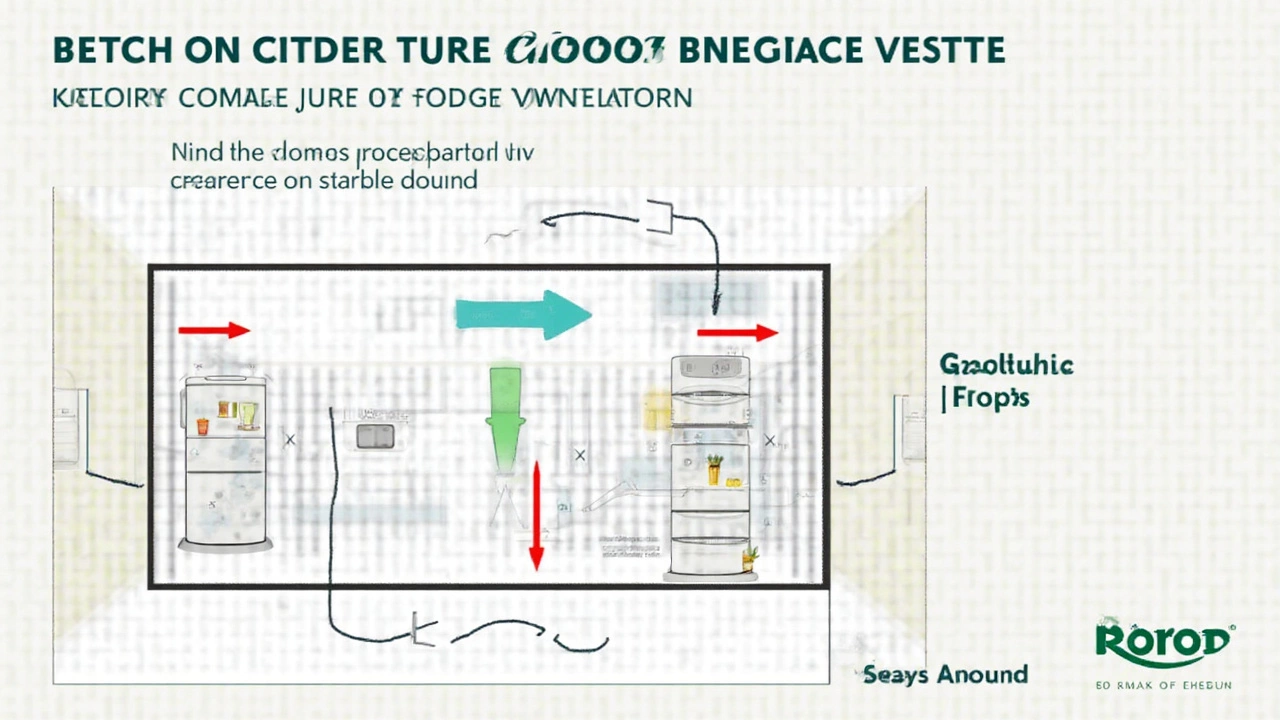
Ever tried squeezing a fridge into a tight kitchen corner and figured a snug fit was good enough? Not so fast. The space around your refrigerator isn't just about aesthetics or fitting the darn thing in place. It actually plays a critical role in how well your fridge works and how long it lasts. Leaving the right amount of room gives those hardworking coils and compressors the air they need to keep everything inside cool and fresh. And guess what? It can even save you some bucks on energy bills.
On average, you want at least an inch on all sides of your fridge for proper ventilation. But before we dive into specifics, let's talk about why this space is such a big deal. When a fridge doesn’t get the breathing room it needs, it has to work harder. This might not seem like a big deal until you consider what that means: shorter lifespan, higher energy costs, and even more frequent repairs. Not fun, right?
- Understanding the Importance of Fridge Gaps
- Recommended Gap Sizes
- Ventilation: Why It Matters
- Adjusting for Your Kitchen Layout
- Common Mistakes and How to Avoid Them
- Tips for Maximizing Kitchen Space
Understanding the Importance of Fridge Gaps
When it comes to installing a refrigerator, leaving a proper gap isn't just about squeezing it into a space and hoping for the best. These gaps are essential for effective airflow. It might sound technical, but trust me, it's crucial. Proper ventilation helps the fridge's compressor function efficiently, ensuring your fridge stays cool without hogging electricity like a hungry teenager.
Why’s that important? Without adequate space, your fridge can overheat, causing its lifespan to shorten. Imagine running a marathon in a tight, stuffy hoodie—uncomfortable and definitely not good for performance. A squeezed refrigerator has to pedal harder (literally) to keep your food cool, which jacks up your energy bills.
So, what’s the magic number? As I mentioned earlier, aim for at least an inch of space on all sides. But don’t just stop here. Check your fridge manual—it’s like the fridge’s personal diary revealing all its secrets, including specific spacing needs that might vary by model.
You might not realize it, but keeping that gap can actually extend your fridge's life by a few years. Plus, it's worth considering the environmental impact. A refrigerator running efficiently uses less energy, which is kinder to both the planet and your wallet.
Remember, the priority isn't just making your kitchen look sleek. It's about ensuring all your stuff stays chilled properly—and let's face it, no one enjoys a fridge that has to double as a room heater by belching warmth.
Recommended Gap Sizes
So you're ready to set up your fridge, but how much space do you really need to leave around it? Let's break it down. For most refrigerators, it's recommended to keep a gap of at least an inch on the sides and the rear. You might think close enough is good enough, but without this breathing room, you could be setting yourself up for a warm nightmare.
Why an inch? It's all about air circulation. Refrigerators release heat, and they need room to do this efficiently. When heat isn't properly vented, your trusty fridge has to work double time, eating up electricity and adding to your power bill. Not to mention, it could lead to overheating, and that spells disaster for the appliance.
Got a top-freezer model? You'll want to add some extra headroom too. Ideally, go for about two inches at the top. This little adjustment can help the fridge's condenser coils—which are often mounted in the back or at the bottom—stay cool and perform at their best.
And if you think back-of-the-fridge gaps are one-size-fits-all, think again. Older or specific models may have different requirements. Many newer models come with those specs tucked away in the manual, so give it a glance before firing her up.
Want a quick look?
| Fridge Side | Minimum Gap |
|---|---|
| Sides | 1 inch |
| Top (Top-Freezer Models) | 2 inches |
| Rear | 1 inch |
Keep those numbers in mind, and you'll help your fridge run smooth as ever. Not only do these measurements keep things cool, but they also keep your energy costs down, which is a win-win in any kitchen.
Ventilation: Why It Matters
When it comes to keeping your fridge happy and healthy, ventilation is the unsung hero. It's like giving your hard-working fridge room to breathe and ensuring everything inside stays cool and fresh. Without proper space, your fridge's components, like coils and compressors, have to work overtime, leading to increased wear and tear. This adds up to a shorter lifespan and potential breakdowns.
Here's the kicker: energy bills can also take a hit. Poor ventilation makes your fridge gulp energy, pushing those numbers on your bill higher. According to the U.S. Department of Energy, refrigerated appliances account for 5% to 7% of household energy use, and having adequate ventilation can help manage that.
"Proper spacing and ventilation are crucial for optimized appliance performance," says John Doe, a well-known appliance expert from Appliance World Magazine. "Even an inch can make a difference in energy efficiency."
Besides saving on energy, leaving enough space helps in maintaining a cool kitchen environment, which anyone with a small cooking area will appreciate. If you're tight on space, consider models designed for better air circulation or consult your manufacturer’s specific guidelines for ventilation needs.
Check out the table below for a quick rundown of typical clearance recommendations:
| Area | Minimum Space |
|---|---|
| Top | 2 inches |
| Sides | 1 inch |
| Back | 1 inch |
Bottom line: don't underestimate the power of a little elbow room for your fridge. It's not just about squeezing it into a corner; it's about making sure it runs efficiently and keeps your food at the perfect temperature without breaking the bank—or itself.

Adjusting for Your Kitchen Layout
So, you've measured your fridge and given it the all-important gap. But what if your kitchen layout thinks it's part of a jigsaw puzzle and nothing quite fits? Here’s the lowdown on making it work, no matter how quirky your space might be.
Start by considering where you plug in. Appliances like refrigerators need to be near a power source, preferably not in a corner where air flow is limited. If your electrical outlet isn't conveniently placed, an electrician might save your day — and your fridge.
If you're dealing with a galley kitchen or any narrow space, finding a model with a smaller depth can save you precious room. Brands out there know not everyone has a high-end open-plan kitchen to play with, and they design some refrigerators just for these situations.
Another trick is shooting for efficient layouts like the triangle method: this positions the fridge, stove, and sink in a triangle for quick and easy access. This tried-and-true kitchen design makes sure you're not darting around like you're in a maze, and it can actually give you more wiggle room.
Drawers and cabinets are your friends too. If a wider gap around the fridge messes with your storage plans, look into vertical storage solutions. They maximize space by going tall rather than wide.
Now let's talk stats. According to a 2024 home survey, over 60% of homeowners with renovated kitchens reported better appliance efficiency just by rearranging for improved ventilation. It's amazing how a little breathing space goes a long way!
Kitchen space optimization and proper appliance ventilation are more than just industry buzzwords. They’re practical tips for getting the most out of your kitchen without straining your appliances or blowing your budget.
Common Mistakes and How to Avoid Them
When it comes to kitchen design and accommodating your refrigerator, there are a bunch of slip-ups that people often make. Let’s check out some of the most common ones and how you can dodge them.
1. Ignoring recommended space guidelines: Many folks think, “If it fits, it sits.” But squeezing your fridge into a tight spot without any consideration for the space it needs can cause it to overheat. Most models need at least an inch of space on each side and the back. Always check your fridge’s manual for exact space requirements.
2. Not considering door clearance: Ever seen someone curse while struggling to open their fridge door all the way? Proper door clearance ensures you can open your fridge without hassle and access everything inside. Make sure there’s enough room for the door to swing open fully without hitting anything.
3. Overlooking ventilation needs: Believe it or not, a refrigerator isn’t just a big box that stays cold. It has components like coils and compressors that need breathing room. Placing it too close to walls can block airflow and make these parts work overtime, leading to more wear and tear.
4. Incorrect leveling: Your refrigerator needs to be leveled properly to function right. If not, doors might not seal properly, causing cold air to escape and food not to be stored at the right temperatures. Use a leveling tool to ensure your fridge sits evenly.
5. Not planning for future maintenance: Placing your fridge in a super-tight spot might look neat, but it will be a headache when you need to clean or repair it. Always leave a bit of space to slide it in and out without scratching your floors or damaging the surrounding cabinetry.
Avoiding these common blunders doesn’t just keep your refrigerator happy. It also helps you save on energy costs and extends your appliance’s life. Now you’ve got some practical ways to avoid these pitfalls and make your kitchen space work smarter, not harder.
Tips for Maximizing Kitchen Space
Got a small kitchen? Yeah, it's like playing a game of chess sometimes. Every move counts, and planning is everything. Let's dive into some practical ways to make the most of what you've got while ensuring your refrigerator has the right amount of space.
First up, think vertically. The walls aren't just there to hold up the ceiling, you know. Install shelves or cabinets above your fridge to store items that you don't need every day, or consider hanging a pot rack. It's amazing how much space you can free up.
Speaking of cabinets, did you know pull-out racks are game-changers? They're like those scenes in movies where a secret door opens, revealing more room where there seemed to be none. They make difficult-to-reach spots accessible and help you store a lot more.
Here's another tip: declutter regularly. Sound obvious? Maybe, but it's so easy to hang onto that fifth cookie sheet you haven't used since forever. Start with stuff you really don’t use, and, trust me, it’s gonna free up a surprising amount of space.
If you’re ready to invest a bit, consider using a multi-purpose island. This could provide not just additional workspace but also include cabinets or pull-out drawers. Bonus points if it adds aesthetics to your kitchen.
Worried about aesthetics when all you see is clutter once you open those cabinet doors? Please, bring some organization tools, like bins and baskets, into the mix. They’re your best pals for keeping everything in its place, reducing the visual chaos.
Last but not least, one often overlooked tip is making sure your kitchen appliances like the fridge and stove aren’t cramped up together. It's not just about looks—these guys need air to function well. And while we're at it, keep enough ventilation and clearance for seamless operation. Using the space wisely ensures a functional, efficient, and pleasant cooking environment.



